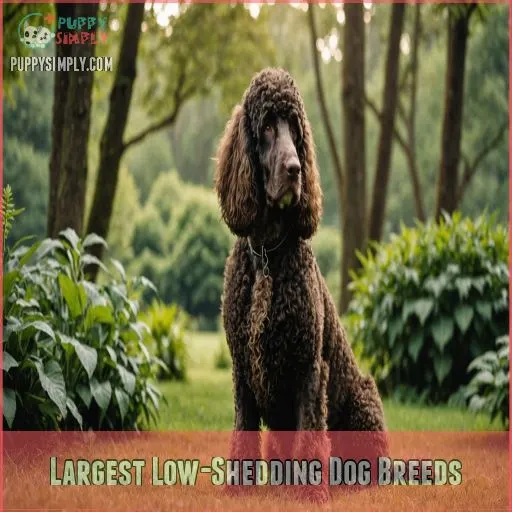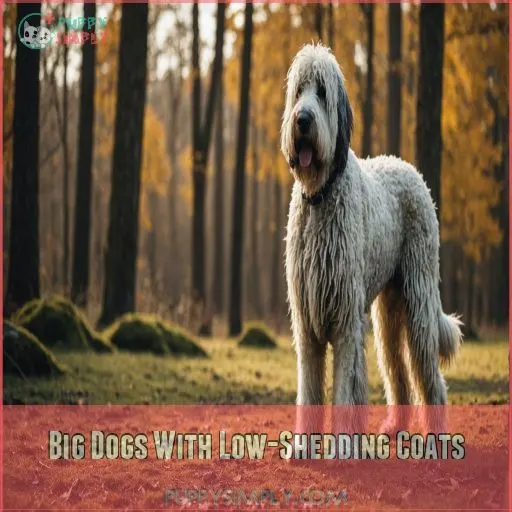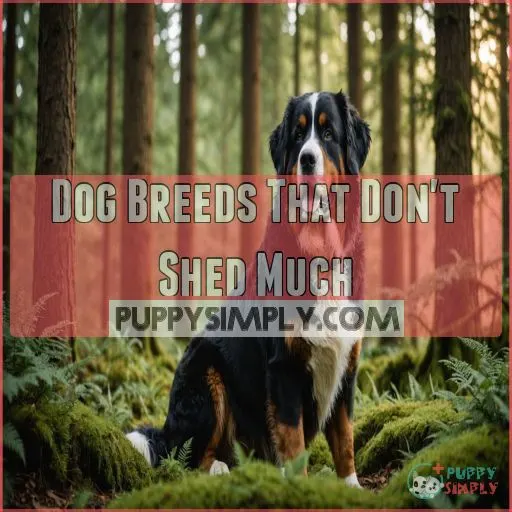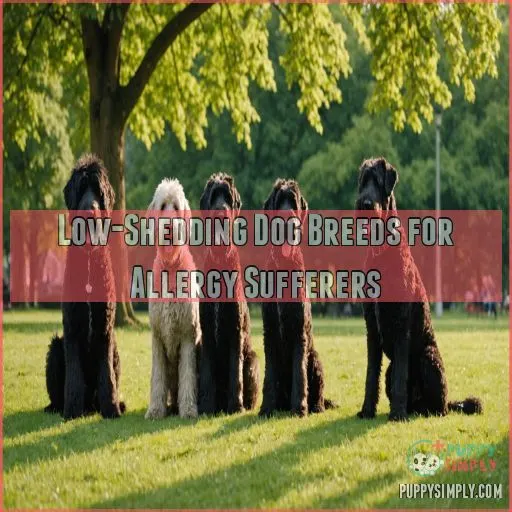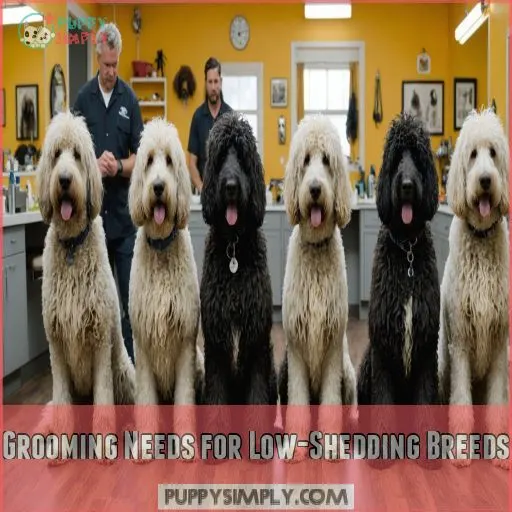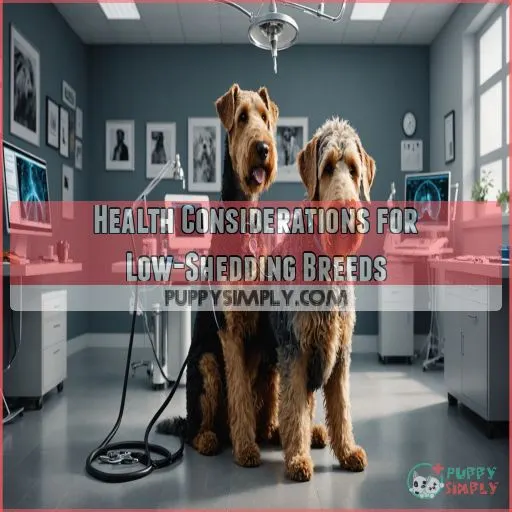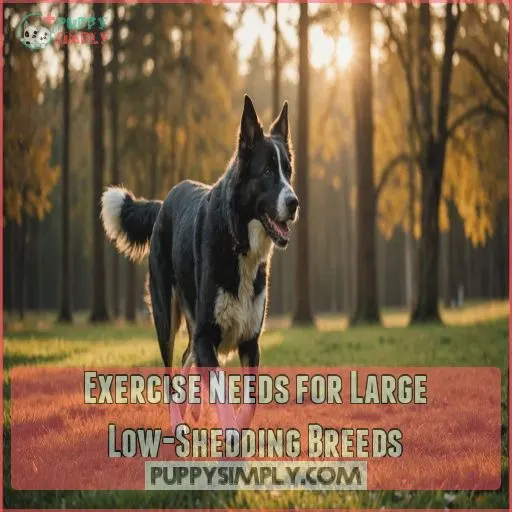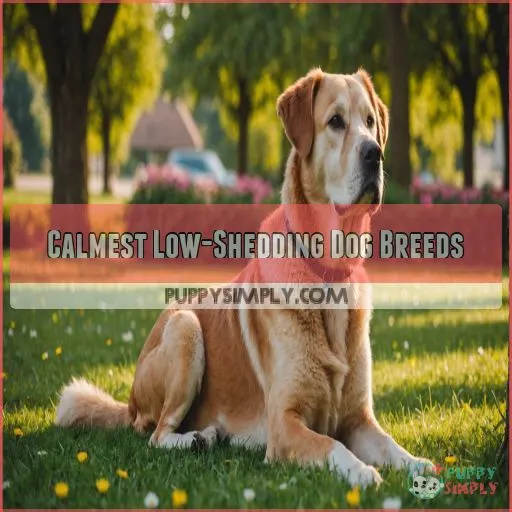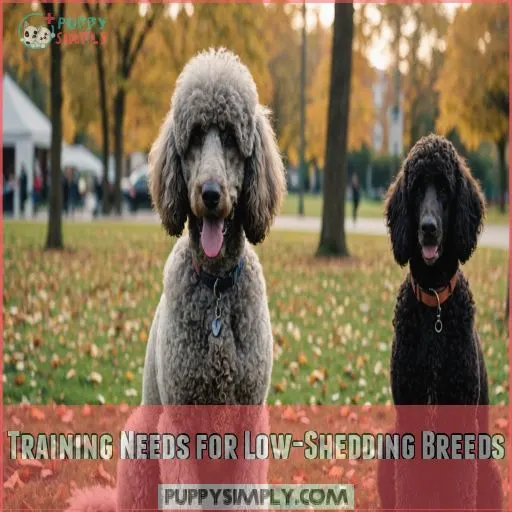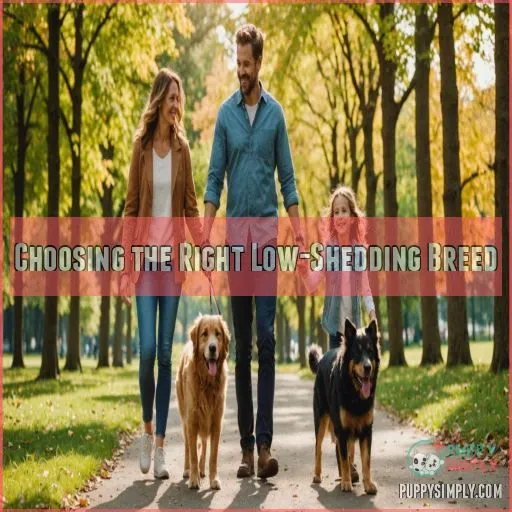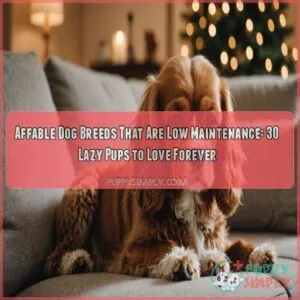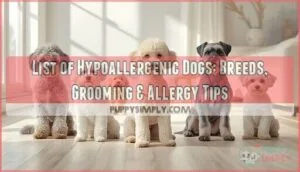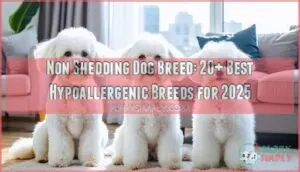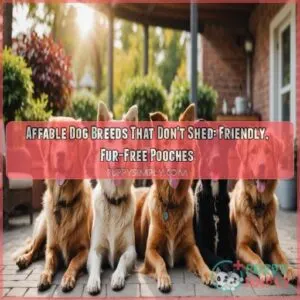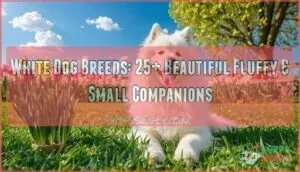This site is supported by our readers. We may earn a commission, at no cost to you, if you purchase through links.
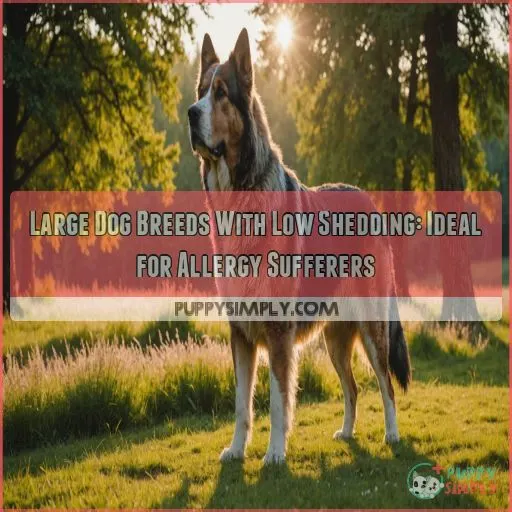
Imagine having your cake and eating it too—big fluffy friends that don’t shed much!
These breeds are perfect for those who appreciate a tidy home and adore big dogs. Just remember, while their coats might be low-shedding, they still require love and care (and occasionally, a brush or two!).
Curious about how they maintain their suave charm with minimal shedding? Keep reading!
Table Of Contents
- Key Takeaways
- Largest Low-Shedding Dog Breeds
- Big Dogs With Low-Shedding Coats
- Dog Breeds That Don’t Shed Much
- Low-Shedding Dog Breeds for Allergy Sufferers
- Grooming Needs for Low-Shedding Breeds
- Health Considerations for Low-Shedding Breeds
- Exercise Needs for Large Low-Shedding Breeds
- Calmest Low-Shedding Dog Breeds
- Training Needs for Low-Shedding Breeds
- Choosing the Right Low-Shedding Breed
- Frequently Asked Questions (FAQs)
- Which large dog breed sheds the least?
- What is the calmest non-shedding dog?
- How often do low-shedding big dogs need to be bathed?
- What are the potential health issues for large hypoallergenic dogs?
- How do I introduce a low-shedding big dog to my family?
- Can low-shedding big dogs be left alone for long periods?
- What are the best ways to manage allergies with a low-shedding big dog?
- Conclusion
Key Takeaways
- If you’re dreaming of a big, furry friend without the pesky fluff storm, breeds like the Airedale Terrier, Afghan Hound, and Giant Schnauzer can be your perfect companions! These playful pooches are big on personality and low on shedding, though they do need regular grooming to maintain their charming looks.
- Keep in mind that bringing one of these delightful giants home means more than just enjoying their company—it’s also about commitment. Regular grooming and the right tools are essential to keep their coats fabulous and mat-free. Consider it quality bonding time, and maybe even a chance to unleash your inner stylist!
- Health is a biggie! Just like us, these lovable mutts need a balanced diet and regular vet check-ups to stay in tip-top shape. Choosing omega-3-rich foods can do wonders for their health and coat shine, keeping them the envy of the dog park.
- Training and socialization are the secret ingredients to a happy life with your low-shedding buddy. From housebreaking to leash training, a little patience and some tasty treats go a long way. Think of it as shaping a well-behaved friend who’s ready to fit perfectly into your family scene.
Largest Low-Shedding Dog Breeds
If you’ve got your heart set on a large dog but dread a house full of fur, don’t worry, there are breeds perfect for you.
Gigantic yet gentle giants like the Airedale Terrier, Afghan Hound, and Giant Schnauzer offer a blend of minimal shedding and big personalities, making them the perfect companions without turning your home into a fuzz festival.
Airedale Terrier: Characteristics and Grooming Needs
The Airedale Terrier, the "King of Terriers," is a large dog breed with a spirited personality and a low-shedding coat—an ideal choice if you’re ready for their grooming needs!
- Temperament: Energetic and intelligent, ready for adventure.
- Training: Quick learners, best with consistent routines.
- Exercise: Needs daily walks and playtime.
- Grooming Needs: Regular brushed curls, occasional trimming—goodbye, dog hair tumbleweeds!
Afghan Hound: Low-Shedding but High-Maintenance Coat
If you’re thinking about getting an Afghan Hound, you’ve got to roll up your sleeves! It’s a low-shedding breed, but its luxurious coat demands time and care.
Debating whether it’s the right breed? Check this table:
| Topic | Details | Humor Tidbit |
|---|---|---|
| Coat Care | Regular brushing | Like styling Rapunzel’s hair! |
| Breed History | Ancient and noble | Practically royalty! |
| Temperament | Aloof but loyal | The cat of the dog world. |
| Exercise Needs | High | Marathon partner, anyone? |
Dive into this delightful challenge and enjoy the journey with your unique companion!
Giant Schnauzer: Working Dog With a Wiry Coat
Diving headfirst into the Giant Schnauzer world, you’ll find a working dog ready to steal your heart.
These large, low-shedding dogs sport a wiry coat that’s surprisingly easy to maintain with regular grooming.
They thrive on structure, so establish a routine.
Giant Schnauzer exercise needs are significant, keeping you both in shape.
Remember, their loyalty is your greatest asset.
Big Dogs With Low-Shedding Coats
If you’re looking for a big, furry friend that won’t leave a trail of tumbleweeds in their wake, you’re in luck.
From the friendly and playful Barbet to the long-coated Briard and the majestic Komondor, these big dogs with low-shedding coats are perfect for allergy sufferers who still want a substantial canine companion.
Barbet: Friendly and Playful With a Low-Shedding Coat
The Barbet is your ticket to a lovable, woolly companion!
With a temperament as friendly as a children’s book character, these large, low-shedding dogs are perfect for allergy sufferers.
Their curly coats need daily grooming to escape tangles—think of it as bonding time.
Hypoallergenic and playful, Barbets cherish splashy fun!
Ideal for owners who crave control and love.
Briard: French Sheep Herder With a Long, Low-Shedding Coat
Ever wish you’d a fluffy cloud for a pet? Meet the Briard, a charismatic French sheepdog with a low-shedding coat that feels like cuddling a cloud, and fewer tufts of fur to vacuum.
Known for its keen intelligence and loyalty, this breed thrives on training and adventure.
Regular grooming is essential—so get started with the right brush and a smile!
Komondor: Hungarian Livestock Guardian With a Corded Coat
Looking for a dog that’s a reliable guardian and a low shedder? Meet the Komondor, a Hungarian treasure with a unique, corded coat reminiscent of a mop.
This breed’s lively temperament requires lots of space and training.
It might turn heads when you’re out and about, but maintaining those dreads demands some dedication—a small price for such a loyal companion.
Dog Breeds That Don’t Shed Much
If you’re looking for a furry friend that won’t leave a trail of hair all over your home, there are several large dog breeds that shed very little.
From the curly-coated Standard Poodle to the unique Peruvian Inca Orchid, these low-shedding pups are perfect for allergy-prone pet owners.
Peruvian Inca Orchid: Hairless Variety With Low-Shedding
Searching for a unique companion that doesn’t shed much and is kind to allergies? Try the Peruvian Inca Orchid!
This hairless, low-shedding breed needs a little extra skin care and sun protection, but its lack of fur makes grooming a breeze.
Perfect for those warmer climates, their affectionate temperament will steal your heart without triggering sneezes.
Poodle (Standard): Hypoallergenic and Low-Shedding Coat
The Peruvian Inca Orchid might’ve caught your interest with its unique hairless charm, but let’s chat about the Standard Poodle. Known for being hypoallergenic, these large dog breeds offer low shedding with their curly, dense coats.
Poodle grooming is a breeze when handled regularly.
With proper Poodle coat care, you’ll enjoy a clean home and a happy pup.
Portuguese Water Dog: Waterproof Coat With Low Shedding
If you’ve got allergies but love big dogs, a Portuguese Water Dog is your catch!
With its waterproof coat, this breed hardly sheds, making it great for allergy sufferers.
Like a kid in a candy store, it loves water and playtime.
Regular grooming and training help keep them healthy and happy.
Their gentle nature brings warmth and smiles!
Low-Shedding Dog Breeds for Allergy Sufferers
If you’re an allergy sufferer looking for a furry friend, you’re in luck!
Certain large dog breeds are known for their low-shedding coats, making them a great choice.
However, it’s important to understand that even "hypoallergenic" pups can trigger reactions due to dander, saliva, or urine.
Hypoallergenic Breeds: Not a Guarantee for Allergy Sufferers
While you might think hypoallergenic breeds are the silver bullet for dog allergies, it’s not always the case.
Those pesky allergies can still sneak up on you with dander from non-shedding dogs.
- Spend time with the dog before deciding.
- Talk to your doctor about allergy tests.
- Consider breed specifics and how they match your lifestyle.
Understanding Dander, Saliva, and Urine Allergens
Despite what you might hear about hypoallergenic dog breeds, it’s important to know allergens don’t take a backseat.
With large dog breeds, watch out for dander, saliva, and urine—allergen trio.
Get allergy testing!
You’re not barking up the wrong tree by managing your environment through dander reduction techniques, turning potential misery into a tail-wagging, sneeze-free home.
Grooming Needs for Low-Shedding Breeds
When you bring home a low-shedding dog, don’t think you’re off the hook for grooming—it’s like owning a magic carpet; you’ll love the lack of shedding, but maintenance is key!
Regular brushing and professional grooming keep your furry friend looking stunning and prevent dreaded tangles and mats.
Regular Brushing and Combing for Low-Shedding Breeds
Brushing and combing are essential for keeping your low-shedding pup’s coat in tip-top shape.
Invest in the right tools – a slicker brush, undercoat rake, and metal comb – and get into a weekly routine.
This helps remove loose hair, prevent mats, and distribute natural oils for a healthy, shiny coat.
Your furry friend will thank you!
Importance of Professional Grooming for Low-Shedding Breeds
You’re probably brushing your low-shedding dog faithfully, but don’t forget about professional grooming! It’s like a spa day for your furry friend, keeping their coat in excellent condition and preventing pesky mats.
Besides, it can help manage allergies by reducing pet hair around the house.
Sure, it might cost a bit, but it’s worth every penny for those big cuddly pals.
Tools and Techniques for Grooming Low-Shedding Breeds
Taking care of large dog breeds that don’t shed much requires the right grooming tools.
Think of it as a hair spa day! You’ll want:
- Slicker brush: Perfect for mat prevention.
- Steel comb: Great for finding hidden tangles.
- Dog shampoo: Keeps coats fresh and clean.
Remember, regular pet care helps your furry friend’s coat stay fabulous and healthy.
Health Considerations for Low-Shedding Breeds
Taking care of your low-shedding dog goes beyond just keeping their coat shiny—it’s like maintaining a finely tuned machine!
Regular check-ups with the vet and a balanced diet are essential to catch any pesky issues early and keep your fluffy friend in top shape.
Importance of Regular Veterinary Check-Ups
Regular vet checkups are a must for your low-shedding pup.
These visits allow your veterinarian to catch any potential health issues early, ensuring your furry friend stays happy and healthy for years to come.
From preventative care like vaccinations to parasite control, these routine visits are the key to a long, fulfilling life.
Diet and Nutrition for Low-Shedding Breeds
A robust diet can work wonders for your large, low-shedding dog breed.
Tailor meals to support coat health and tackle any food allergies.
Opt for omega-3-rich foods to boost shine and minimize shedding.
Consider supplements to meet their unique needs.
Remember, a healthy diet’s like a good insurance policy—keeps your furry friend happy, and helps avoid surprises.
Common Health Issues in Low-Shedding Breeds
Veterinarians often warn that low-shedding dog breeds, like these gentle giants, can face common health issues.
Watch out for skin allergies, eye problems, ear infections, joint issues, and dental concerns.
Regular check-ups and a balanced diet can help extend their lifespan. Keeping them healthy is like maintaining a well-oiled machine – a little attention goes a long way for these lovable fur machines.
Exercise Needs for Large Low-Shedding Breeds
Exercise is important for your low-shedding fur buddy, and understanding their energy levels helps satisfy their zest for life.
From the sprinting Greyhound to the chill Saluki, each breed offers a unique burst of joy, whether you need a jogging partner or a Netflix snuggle buddy.
High-Energy Breeds: Greyhound, Irish Water Spaniel, and Komondor
If you’re seeking a canine companion with boundless energy, the Greyhound, Irish Water Spaniel, and Komondor are your high-octane picks.
These big dogs need ample room to romp and play – think fenced yards, daily jogs, and plenty of fetch sessions.
Their lively spirits demand an active lifestyle, so be ready to match their zest for life!
Moderate-Energy Breeds: Barbet, Briard, and Standard Poodle
If you’re hoping for moderate-energy pals that don’t shed much, consider the Barbet, Briard, and Standard Poodle.
These charming pooches will make your heart melt with their unique qualities:
- Grooming Galore: Keep their coats tidy with regular brushing.
- Temperament Treasures: They’re affectionate and smart!
- Training Triumphs: Ready to learn, perfect for obedience sessions.
Low-Energy Breeds: Saluki and Peruvian Inca Orchid
Ever wonder why low-energy breeds like the Saluki and Peruvian Inca Orchid are perfect for your lifestyle?
Salukis bring a calm temperament, while the hairless Peruvian Inca Orchid requires just a dash of care.
Enjoy their serene vibes with minimal fuss over grooming or exercise.
They’re the epitome of relaxation—an easygoing companion, ideally suited for a low-shedding breed adoption.
Calmest Low-Shedding Dog Breeds
Finding a calm, low-shedding dog breed can make life a little easier for those of us who prefer less fur on our clothes and sofas.
You might think these laid-back pooches, like the quiet Basenji or the distinguished Saluki, skipped the barking debate club and went straight to champion lounging status.
Basenji: Known as the Barkless Dog
The Basenji, often called the "barkless dog," is a calm and affectionate companion.
Despite its large size, this ancient African breed is known for its quiet demeanor and minimal shedding.
Basenjis thrive on companionship and make loyal, devoted pets.
With their short, smooth coats, they’re a great choice for allergy-prone families seeking a low-maintenance, low-shedding big dog.
Saluki: Calm and Shy With a Short Smooth Coat
Salukis, with their elegant and ancient history, are the epitome of grace in large dog breeds.
These quiet companions are calm and slightly shy, boasting a smooth short coat that requires minimal grooming.
Offering the freedom of low shedding, they’re perfect for allergy-sensitive households.
Just remember, these beauties need moderate exercise—a brisk walk will keep them dapper and content!
Goldendoodle: Hypoallergenic and Calm Family Dog
Goldendoodles are often the cream of the crop for families itching for a hypoallergenic, low-shedding companion.
As calm as a Sunday stroll, these versatile pups balance fun with tranquility.
Regular grooming keeps their curly coats tangle-free, ideal for allergy sufferers.
Train them with treats and patience, and you’ll nurture a gentle giant ready to fit right into family life.
Training Needs for Low-Shedding Breeds
Training your new low-shedding dog breed is essential to make sure they become well-behaved family members who won’t shed chaos (or much fur) around your home, especially if you’re looking for a breed with low maintenance.
Start with early socialization and housebreaking, mixing in obedience training, and you’ll have a loyal companion who knows the ropes—with hardly any mess left behind!
Importance of Early Socialization and Training
Early socialization and training are important for low-shedding big dogs.
These pups need to learn good manners and develop social skills from a young age.
Proper training helps prevent behavior issues and makes sure your gentle giant is well-behaved at the dog park and beyond.
Start with puppy classes and continue building their confidence through positive reinforcement.
- Puppy socialization
- Obedience training
- Behavior modification
Training Techniques for Low-Shedding Breeds
Training low-shedding breeds is as rewarding as finding the perfect latte! When working with these dogs, positive reinforcement is key—treats and praise go a long way.
Crate training offers your dog security, while socialization builds confidence.
Remember: patience and consistency are your allies. These techniques help teach leash manners, creating well-behaved companions.
| Technique | Benefits |
|---|---|
| Positive Reinforcement | Builds trust and motivation |
| Crate Training | Provides security |
| Leash Manners | Encourages control |
| Socialization | Enhances confidence |
Housebreaking and Obedience Training
Alright, time to roll up those sleeves for housebreaking and obedience training!
Tackling these with your low-shedding pup means:
- Crate training: Think of it as their cozy den.
- Potty training: Consistency is key!
- Leash training: Walks should be a breeze.
- Basic commands: Make "sit" your best friend.
Feel confident knowing your furry pal will fit right into your home.
Choosing the Right Low-Shedding Breed
Picking the perfect low-shedding dog for your home is like finding a new friend that doesn’t leave their sweater behind after every playdate.
Consider your lifestyle, research breed characteristics, and make sure to meet the breed in person before deciding,
because you wouldn’t choose a roommate without a proper introduction, would you?
Considering Lifestyle and Living Situation
When picking the right dog, think about your lifestyle. Are you living in an apartment with large animals? You’ll need a breed adaptable to limited space.
| Factors | Considerations | Tips |
|---|---|---|
| Space Requirements | Apartments or houses | Choose a compact, calm breed |
| Activity Level | Energetic or laid-back | Match breed energy to yours |
| Grooming Commitment | High or low | Don’t dodge grooming duties |
| Family Compatibility | Kids or no kids | Opt for family-friendly pup |
| Climate Suitability | Hot or cold areas | Pick a climate-fit coat |
Find a balance; it’s not rocket science, just dog-sense! Think about Space Requirements, Grooming Commitment, and Climate Suitability when choosing the right dog.
Researching Breed Characteristics and Needs
Researching dog breeds is a bit like finding your soulmate without the drama!
Explore the following key factors:
- Temperament & Companionship: Make certain they’re good with both.
- Grooming & Allergy Needs: Don’t skip the fur details!
- Exercise & Socialization Requirements: Essential for harmony.
Balancing these makes choosing the perfect low-shedding dog breed a fun adventure!
Meeting the Breed in Person Before Making a Decision
Meeting a breed in person is like a first date; you quickly know if there’s chemistry.
Test for allergies, assess temperament, and observe energy levels. If the dog doesn’t fit your lifestyle, no hard feelings!
Visit breed events to see them in action. They’re ideal for both active lifestyles and cozy apartments, mingling well with kids and other dogs, perfect for active lifestyles.
Frequently Asked Questions (FAQs)
Which large dog breed sheds the least?
A Komondor sheds less than a feather in a snowstorm with its remarkable corded coat.
It’s low maintenance in shedding but demands care, giving you the freedom and control to keep your home relatively hair-free.
What is the calmest non-shedding dog?
If you’re looking for a calm, non-shedding companion, the Basenji is your ticket to tranquility.
Known as the "barkless dog," this affectionate fellow enjoys a good snuggle and is as serene as a summer breeze.
How often do low-shedding big dogs need to be bathed?
Bathing a low-shedding big dog can be like a spa day gone mad.
Generally, you should bathe them monthly, but adjust based on activity and coat condition.
Just guarantee you balance cleanliness with their comfort and skin health.
What are the potential health issues for large hypoallergenic dogs?
Larger hypoallergenic dogs, like Poodles or Portuguese Water Dogs, can face common big dog woes such as hip dysplasia or bloat.
They can be kept in tip-top shape with regular vet visits, balanced chow, and gentle exercise.
How do I introduce a low-shedding big dog to my family?
Bringing a low-shedding big dog into your family?
Start by creating a calm space, introduce them gradually, and establish a routine.
This helps them feel at home in no time!
Let love and patience be your guide!
Can low-shedding big dogs be left alone for long periods?
Low-shedding big dogs can often tolerate being left alone.
However, it’s imperative to ascertain they’re engaged and comfortable, as they mightn’t thank you for hours of solitude!
Providing toys, exercise, and affection helps immensely.
What are the best ways to manage allergies with a low-shedding big dog?
Dealing with allergies? Keep allergens at bay by using air purifiers, bathing your dog regularly, and brushing them often.
Test your allergy thresholds with brief visits and chat with specialists about allergy-friendly breeds and medication options.
Conclusion
Picture your life with a majestic, low-shedding canine companion—a marvel that brings all the joy of a large dog breed without the fluff storm.
By choosing a large dog breed with low shedding, your allergies could become a distant memory.
Just remember, even these dapper dogs need consistent grooming and care.
So begin your search with curiosity and heart, as these gentle giants are ready to join your family, offering love and loyalty aplenty.

